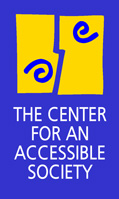
DISABILITY
ISSUES
INFORMATION
FOR
JOURNALISTS
TOPICS
ABOUT
THE CENTER
How would you feel if you suddenly needed the help of others to perform basic tasks like eating, bathing, or dressing. Would you rather get that assistance in your own home or in a nursing home?
For most people, the question doesn't require much thought: they'd prefer to retain control over their own needs by living at home, paying a personal assistant if necessary. Unfortunately, however, government policy is skewed toward keeping Americans in need of long-term assistance in institutions, and the nursing home lobby is determined to keep things just the way they are.
Millions of Americans depend on Medicaid to finance their long-term services. But 80 percent of all Medicaid long-term care funds go to nursing homes and other institutional service providers. Only 20 percent supports people living in the community. To be blunt, the government is now spending $45 billion a year to warehouse 2 million Americans, many of whom could receive services in their own homes. This issue will become more acute as the U.S. population ages. Today, roughly 13 percent of the population is over age 65, with 2 percent over age 85. By the year 2040, however, the percentage of Americans over 65 will jump to 21 percent, including 4 percent over 85, thanks to the demographic phenomenon of the "baby boom."
What are 'personal assistance services'?
"For a person with a disability, a personal assistant can make the difference between living in the community or being institutionalized," says the World Institute on Disability "Access to personal assistance truly is our insurance policy for staying healthy, well, and productive," says Bob Williams, who served as Deputy Assistant Secretary for Disability, Aging and Long Term Care Policy, U.S. Department of Health and Human Services in the Clinton administration.
The federal and state bias toward institutional services dates to the 1960s, when the Medicaid and Medicare programs were created. At the time, it was thought that institutional settings provided the best care for all Americans needing long term services. Today, however, it has become clear most people prefer the freedom and control of living at home and hiring a personal assistant if necessary.
Government policies are slow to offer people greater choices in where they get services because because of fear that costs will escalate if people are given a choice. Many people today, it is argued, get assistance at home from friends and relatives at no government cost - because people want to stay out of nursing homes. But if federal and state governments freed more money for in-home services, the theory goes, these people would "come out of the woodwork" and demand the service, raising costs to untold billions.
Researchers with the Disability Statistics Center counter that the the number of people who would apply for federal and state assistance is actually relatively simple to calculate, and the de-institutionalizing of people currently in nursing homes would save enormous amounts of money. Many states have found that community-based attendant services are less expensive than institutional services. Oregon, for example, has aggressively tried since 1982 to provide services for people in their homes, and found they can serve three people in the community for the cost of every one in a nursing home.
The demand for greater choice in personal assistance services is growing every year, and is sure to intensify as the baby boomers grow older.
"The typical definition of personal assistance is that of one person assisting another with tasks that the individual would do for himself or herself if it were not for a disability," says Williams. "My definition is more expansive in that to me it includes any form of assistance that I require and use to lead life as I choose. This includes a great deal of assistance from my partner and others with everyday tasks. -- tasks such as bathing, dressing, eating, and managing the paper flow that threatens to overtake my desk and my life.
"But it also includes much more. Like the assistance I receive getting up from the floor or walking across an uneven path of ground or ice from my trusty canine confidant, Decoy de Mutt. Or, the increasing assistance and productivity that I look for, and frankly demand, that my Liberator [a computerized voice synthesizer] and other assistive devices provide.
"In sum, for me personal assistance includes any sort of assistance that people with disabilities rely on to make our lives more personally and professionally productive.
Powerpoint presentation (from the Center for Personal Assistance Services):
Unmet Need for Personal Assistance Services. LaPlante, M.P., Kaye, S., Kang, T., & Harrington, C. (2003, November 18). Presented at the 131st Annual Meeting and Exposition hosted by American Public Health Association.
The Independent Living Research Utilization Olmstead project provides disabiliity advocacy training on the Olmstead decision; their website offers resources.
Consumer Choice and Control:
The Jan. 24 New York Times noted the "growing number of severely disabled people who are turning to personal assistants to help them keep up with the daily grind or even carve out successful careers."
Directory of Publicly Funded Personal Assistance Programs from the World Institute on Disability
"Understanding Medicaid Home and Community-Based Services: A Primer" -- from the U.S. Dept. of Health and Human Services, available at http://www.aspe.hhs.gov/daltcp/reports/primer.htm
Information on Home & Community-Based, Consumer-Directed, and Personal Assistance Services from the Office of Disability, Aging and Long-Term Care Policy at the U.S. Dept of Health and Human Services
OTHER ITEMS OF INTEREST:
The Center for Personal Assistance Services provides research, training, dissemination and technical assistance on issues of personal assistance services (PAS) in the United States.
Download Powerpoint
Personal Attendant Services and Supports in
America: Report of the National Blue Ribbon Panel on
Personal Assistance Services, August, 1999
Overview
Abuse of seniors under-reported, says study
The Institutional Bias of Public Policy
Consumer Direction in Personal Assistance
Study Validates Consumer Control's Superiority
In-home services: Implementing the Olmstead decision